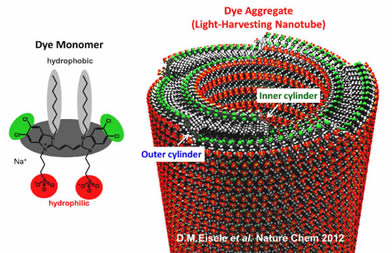Researcher Spotlight
Dye nanotubes as a means of harvesting light - MIT-Harvard Center for Excitonics

Dorthe Melitta Eisele, a postdoctoral researcher in the Center for Excitonics, has taken her cue from nature. The source of her inspiration is the natural green sulfur bacterium – a nanoscale creature which lives in the ocean. It is only about a micrometer long and does something very successfully that scientists want to emulate. Despite living in the darkness way down deep, with its uniquely cylindrical parts, it is able to harvest light and to perform photosynthesis with incredibly high efficiency. The green sulfur bacteria, known as Chlorobium tepidum, are one of the oldest photosynthesizers on the planet. Nature had millions of years to bring these photosynthetic units to their current perfection. Scientists want to learn how nature accomplished this high-efficiency light harvesting process, so that one day we may be able to use this knowledge to solve society’s energy problems in a similarly elegant and sustainable way.
Dorthe specifically wonders if there isn’t something special about this cylindrical shape of the bacteria’s light harvesting unit. She is pursuing a line of inquiry involving a synthetic version that may someday successfully mimic this behavior: artificial light-harvesting nanotubes containing nanotubular dye aggregates (Figure 1a).

Figure 1: Dorthe’s artificial light harvesting nanotube (a) consists actually of two light harvesting tubes: an inner cylinder and an outer cylinder that are stacked into each other with a distance of about 4 nm only and that are micrometers long. Importantly, within the tube the dye molecules do not share electrons with one another. But due to their close packing once the molecules are excited (by light) they affect each other, so that they share their excited states. This is the key to their ability to efficiently transfer energy along the tube. (b) Amphiphilic cyanine dye molecule (monomer) that self-assembles in aqueous solution into the double-walled tubular structures shown in (a). Both figures taken from D.M.Eisele et al. Nature Chem. 2012
There has been considerable previous work with the bacteria, including an experiment in which researchers cooled the bacterium and pulsed it with extremely short bursts of laser light. Significantly, what they saw was an internal calculation – an instantaneous quantum computation by the plant, which enabled it to transfer light energy, and in many directions, from one molecule to the next until it reached the reaction center where photosynthesis takes place.1 Dorthe faces the challenge of creating similar wavelike motions of energy through such ultra-tiny systems like her artificial light harvesting nanotubes.
To address such complex challenges, multidisciplinary collaborations are essential; Dorthe’s work illustrates how theorists and experimentalists from physics, chemistry, biology, and materials science successfully work together to elucidate nature’s fascinating secrets. Because Dorthe is trying to replicate behavior of the green sulfur bacteria that is not yet well understood, she begins with experiments, encouraging theorists to find theoretical models to explain the results, or see how far current models can go to explain them.
Dorthe’s system, the artificial light harvesting nanotube (Figure 1a), contains aggregated (i.e., tightly packed) dye molecules form a very tiny tube with a diameter less than 20 nm and a length of several micrometers. Her system, therefore, has similar dimensions like the green sulfur bacteria. The particular dye molecule comprising Dorthe’s tube is an amphiphilic cyanine dye derivative (Figure 1b).2 Dorthe chose this molecule from a whole class of similar molecules synthesized in Germany in the early 1990s by a senior scientist, Prof. Siegfried Daehn,3 whose work she learned about during her doctoral research. She decided to focus on only one particular kind of molecule from this class. Dorthe felt that this was the most efficient way to consistently examine excitonic behavior in one specific artificial system under a variety of conditions. Her ultimate goal is to get a comprehensive understanding of these light harvesting nanotubes and thus perhaps one day contribute to finding a solution to the more efficient transfer of solar energy.
Biologists with special technological tools are an essential part of Dorthe’s multidisciplinary team. As an example, to elucidate the morphology of her tubes, Dorthe works with biologist Prof. Daniela Nicastro at Brandeis University. Working at very cold temperatures Prof. Nicastro’s group uses a special microscope, a cryogenic electron microscope (cryoTEM). Electrons are “shot through” Dorthe’s samples, pictures are taken and even a potential 3D model of what is seen can be constructed on the basis of such pictures.
Recently, Dorthe isolated the behavior of excitons in the inner wall cylinder versus the outer wall cylinder of her nanotube (Figure 1a). Utilizing redox-chemistry as a tool she was able to selectively “turn off” the optical response (absorption) in one part of the cylinder. Her recently published paper4 in Nature Chemistry reports on the evidence from her team’s work that the nanotube’s structure can be best described as two separate weakly coupled excitonic systems and as showing distinct spectral responses. Understanding such interactions is critical to the control of energy transfer on a molecular scale, which is a goal in the various future applications of artificial photosynthesis.
1 G. Engel, T. Calhoun, E. Read, T. Ahn, T. Mancal, Y-C Cheng, R. Blankenship, G. Fleming, Nature 446, 782-786 (12 April 2007). See also Scientific American article based on this paper, “When It Comes to Photosynthesis, Plants Perform Quantum Computation” by David Biello, April 13, 2007.
2 D. M. Eisele, J. Knoester, S. Kirstein, J. P. Rabe, and D. A. Vanden Bout: “Uniform exciton fluorescence from individual molecular nanotubes immobilized on solid Substrates.” Nature Nanotech. 4, (2009) 658-663, Cover Article
3 S. Dähne et al., J. Prakt. Chem. Zeit., (1995)
4 D.M. Eisele, C.W. Cone, E.A. Bloemsma, S.M. Vlaming, C.G.F. van der Kwaak, R.J. Silbey, M.G. Bawendi, J. Knoewester, J.P. Rabe and D.A. Vanden Bout, “Utilizing Redox-Chemistry to Elucidate the Nature of Excitons Transitions in Supramolecular Dye Nanotubes,” Nature Chemistery (2012).






